The Mitigation Potential of Buffer Strips for Reservoir Sediment Yields: The Itumbiara Hydroelectric Power Plant in Brazil
Abstract
:1. Introduction
2. Materials and Methods
2.1. Study Site: Itumbiara HPP, Brazil
2.2. SWAT Model Input Data
- Landuse: The landuse map (Figure 3a) used images from INPE via Landsat-5 satellite TM sensor (Thematic Mapper) with a spatial resolution of 30 m. Complementary images from Japanese satellite ALOS were used, with 2.5 m spatial resolution. Field visits were undertaken to validate the images where necessary. The catchment is dominated by pasture—PAST (42.2%), generic agricultural land—AGRL (27.4%), forest-evergreen—FRST (21.4%), forest-mixed—FRST (6.7%), forest-deciduous—FRSD (0.8%), and barren or sparsely vegetated—BSVG (2.3%).
- Digital elevation model (DEM): A 30 m by 30 m resolution DEM was obtained from the TOPODATA project [28]. The DEM was used to delineate the upstream watershed of the Itumbiara HPP. Sub-watershed parameters such as slope gradient, length, and the stream network characteristics such as channel slope, width, and length were derived from the DEM (Figure 3d).
- Soil data: The soil data of Itumbiara HPP watershed was added to the SWAT soil database manually (at a resolution of 30 m by 30 m). The soil groups were classified using RADAM BRASIL [29] and the FAO’s (Food and Agricultural Organization of United Nations) texture classification for tropical soils. The average altitude of the survey was 12 km at 690 km/h. The imaging system used GEMS (Goodyear Mapping System 1000), which operates at X-band (wavelengths close to 3 cm and often between 8 and 12.5 GHz). In addition, other methodologies were used to provide information on soil type including infrared and multispectral radar images, low altitude overflights, on-site field visits, and petrographic analysis. The soil map of the study watershed is shown in Figure 3b. For the whole catchment, the following soils are present (with percentage abundance in brackets): hapliccambisol—CX (33%), leptsol-regosol—RL + RR (16.5%), red oxisol—LV (13.6%), ultisol—PV (12.7%), gleysol—GX (10.1%), red yellow oxisol—LVA (8.2%), red yellow oxisol-haplic—LVA + CX (5.7%), leptsol—RL (0.2%).
- Hydrometeorological data: The data required for the model included rainfall, river discharge, and climate data (temperatures, solar radiation, humidity, and wind speed). Daily rainfall and climate data was available for one station inside the Itumbiara HPP (shown in Figure 2). The analyzed rain gauge provided data over the period from 1987 to 2013.
3. Results
3.1. SWAT Model Calibration
3.2. Land Management Scenario: Buffer Strip Implementation
- Baseline Scenario: Existing model with no additional vegetation;
- Scenario 1: incorporate a 20 m wide buffer strip around the sub-basin outflows into the reservoir;
- Scenario 2: incorporate a 40 m wide buffer strip around the sub-basin outflows into the reservoir;
- Scenario 3: incorporate a 100 m wide buffer strip around the sub-basin outflows into the reservoir.
- Scenario 4: incorporate a 200 m wide buffer strip around the sub-basin outflows into the reservoir.
3.3. SWAT Model Simulations with Buffer Strips Implemented
4. Discussion
5. Conclusions
Acknowledgments
Author Contributions
Conflicts of Interest
References
- Petkovsek, G.; Roca, M. Impact of reservoir operation on sediment deposition. Proc. ICE-Water Manag. 2013, 167, 577–584. [Google Scholar] [CrossRef]
- Lenhart, T.; Fohrer, N.; Frede, H.-G. Effects of landuse changes on the nutrient balance in mesoscale catchments. Phys. Chem. Earth 2003, 28, 1301–1309. [Google Scholar] [CrossRef]
- Lin, Y.-P.; Hong, N.-M.; Wu, P.-J.; Wu, C.-F.; Verburg, P.H. Impacts of landuse change scenarios on hydrology and landuse patterns in the Wu-Tu watershed in Northern Taiwan. Landsc. Urban Plan. 2007, 80, 111–126. [Google Scholar] [CrossRef]
- Tripathi, M.P.; Panda, R.K.; Raghuwanshi, N.S. Identification and prioritization of critical sub-watersheds for soil conservation management using SWAT model. Biosyst. Eng. 2003, 85, 365–379. [Google Scholar] [CrossRef]
- Mishra, A.; Kar, S.; Singh, V.P. Prioritizing structural management by quantifying the effect of LULC on watershed runoff and sediment yield. Water Resour. Manag. 2007, 21, 1899–1913. [Google Scholar] [CrossRef]
- Mishra, A.; Kar, S.; Raghuwanshi, N.S. Modelling non-point source pollutant losses from a small watershed using HSPF model. J. Environ. Eng. 2009, 135, 92–100. [Google Scholar] [CrossRef]
- Mishra, A.; Kar, S. Modelling hydrologic processes and NPS pollution in a small watershed in sub-humid subtropics using SWAT. J. Hydrol. Eng. 2012, 17, 445–454. [Google Scholar] [CrossRef]
- Sardar, B.; Singh, A.K.; Raguwanshi, N.S.; Chatterjee, C. Hydrological modelling to identify and manage critical erosion prone areas for improving reservoir life: A case study of Barakar basin. J. Hydrol. Eng. 2014, 19, 196–204. [Google Scholar] [CrossRef]
- Eckhardt, K.; Breuer, L.; Frede, H.-G. Parameter uncertainty and the significance of simulated landuse change effects. J. Hydrol. 2003, 273, 164–176. [Google Scholar] [CrossRef]
- Huisman, J.A.; Breuer, L.; Frede, H.-G. Sensitivity of simulated hydrological fluxes towards changes in soil properties in response to landuse change. Phys. Chem. Earth 2004, 29, 749–758. [Google Scholar] [CrossRef]
- Mekonnen, M.; Keesstra, S.D.; Ritsema, C.J.; Stroosnijder, L.; Baartman, J.E.M. Sediment trapping with indigenous grass species showing differences in plant traits in northwest Ethiopia. Catena 2015, 147, 755–763. [Google Scholar] [CrossRef]
- Wanyama, J.; Herremans, K.; Maetens, W.; Isabiry, M.; Kahimba, F.; Kimaro, D.; Poesen, J.; Deckers, J. Effectiveness of tropical grass species as sediment filters in the riparian zone of Lake Victoria. Soil Use Manag. 2012, 28, 409–418. [Google Scholar] [CrossRef]
- Bu, C.F.; Cai, Q.G.; Ng, S.L.; Chau, K.C.; Ding, S.W. Effects of hedgerows on sediment erosion in Three Gorges Dam Area, China. Int. J. Sediment Res. 2008, 23, 119–129. [Google Scholar] [CrossRef]
- Donjadee, S.; Tingsanchali, T. Reduction of runoff and soil loss over steep slopes by using vetiver hedgerow systems. Paddy Water Environ. 2013, 11, 573–581. [Google Scholar] [CrossRef]
- Cao, L.; Zhang, Y.; Lu, H.; Yuan, J.; Zhu, Y.; Liang, Y. Grass hedge effects on controlling soil loss from concentrated flow: A case study in the red soil region of China. Soil Tillage Res. 2015, 148, 97–105. [Google Scholar] [CrossRef]
- Amare, T.; Zegeye, A.D.; Yitaferu, B.; Steenhuis, T.S.; Hurni, H.; Zeleke, G. Combined effect of soil bund with biological soil and water conservation measures in the northwestern Ethiopian highlands. Ecohydrol. Hydrobiol. 2014, 14, 192–199. [Google Scholar] [CrossRef]
- Young, R.A.; Onstad, C.A.; Bosch, D.D.; Anderson, W.P. AGNPS: A nonpoint source pollution model for valuating agricultural watersheds. J. Soil Water Conserv. 1989, 44, 168–173. [Google Scholar]
- Refsgaard, J.C.; Storm, B. MIKE SHE. In Computer Models in Watershed Hydrology; Singh, V.P., Ed.; Water Resources Publications: Highland Ranch, CO, USA, 1995; pp. 809–846. [Google Scholar]
- Arnold, J.G.; Srinivasan, R.; Muttiah, R.S.; Williams, J.R. Large area hydrologic modelling and assessment Part I: Model development. J. Am. Water Resour. Assoc. 1998, 34, 73–89. [Google Scholar] [CrossRef]
- Arnold, J.G.; Allen, P.M. Estimating hydrologic budgets for three Illinois watersheds. J. Hydrol. 1996, 176, 57–77. [Google Scholar] [CrossRef]
- Arnold, J.G.; Fohrer, N. SWAT 2000: Current capabilities and research opportunities in applied watershed modelling. Hydrol. Process. 2005, 19, 563–572. [Google Scholar] [CrossRef]
- Ndomba, P.; Mtalo, F.; Killingtveit, A. SWAT model application in a data scarce tropical complex catchment in Tanzania. Phys. Chem. Earth 2008, 33, 626–632. [Google Scholar] [CrossRef]
- Van Griensven, A.; Popescu, I.; Abdelhamid, M.R.; Ndomba, P.M.; Beevers, L.; Betrie, G.D. Comparation of sediment transport computations using hydrodynamic versus hydrologic models in the Simiyu River in Tanzania. Phys. Chem. Earth 2013, 61–62, 12–21. [Google Scholar] [CrossRef]
- Gassman, P.W.; Reyes, M.R.; Green, C.H.; Arnold, J.G. The soil and water assessment tool: Historical development, applications and future research directions. Trans. ASABE 2007, 50, 1211–1250. [Google Scholar] [CrossRef]
- Cao, W.; Bowden, W.B.; Davie, T.; Fenemor, A. Modelling impacts of land cover change on critical water resources in the motueka river catchment, New Zealand. Water Resour. Manag. 2009, 23, 137–151. [Google Scholar] [CrossRef]
- Tuppad, P.; Kannan, N.; Srinivasan, R.; Rossi, C.G.; Arnold, J.G. Simulation of agricultural management alternatives for watershed protection. Water Resour. Manag. 2010, 24, 3115–3144. [Google Scholar] [CrossRef]
- Mukhtar, M.A.; Dunger, V.; Merkel, B. Assessing the impacts of climate change on hydrology of the upper reach of the spree river: Germany. Water Resour. Manag. 2014, 28, 2731–2749. [Google Scholar] [CrossRef]
- TOPODATA. Available online: http://www.dsr.inpe.br/topodata/ (accessed on 15 January 2015).
- RADAM BRASIL, Projeto RADAM. Parte das Folhas SC.23 Rio São Francisco e SC.24—Aracaju: Geologia, Geomorfologia, Solos, Vegetação e uso Potencial da Terra; Levantamento de Recursos Naturais, v. 01; Ministério de Minas e Energia—Secretaria Geral: Rio de Janeiro, Brazil, 1973. [Google Scholar]
- Liu, Y.; Zhang, X.; Xia, D.; You, J.; Rong, Y.; Bakir, M. Impacts of landuse and climate changes on hydrologic processes in the Qingyi River watershed, China. J. Hydrol. Eng. 2013, 18, 1495–1512. [Google Scholar] [CrossRef]
- Lelis, T.A.; Calijuri, M.L.; da Fonseca Santiago, A.; de Lima, D.C.; de Oliveira Rocha, E. Análise de sensibilidade e calibração do modelo SWAT aplicado em bacia hidrográfica da regiãosudeste do Brasil. Rev. Bras. Cienc. Solo 2012, 36, 623–634. [Google Scholar] [CrossRef]
- Yuang, F.; Ren, L.; Yu, Z.; Zhu, Y.; Xu, J.; Fang, X. Potential natural vegetation dynamics driven by future long-term climate change and its hydrological impacts in the Hanjiang River Basin. China. Hydrol. Res. 2012, 43, 73–90. [Google Scholar] [CrossRef]
- Lu, G.B.; Wang, J.; Wang, H. J.; Xia, Z.Q. Impacts of human activities on the flow regime of the Hanjiang River. Res. Environ. Sci. 2009, 15, 12–13. [Google Scholar]
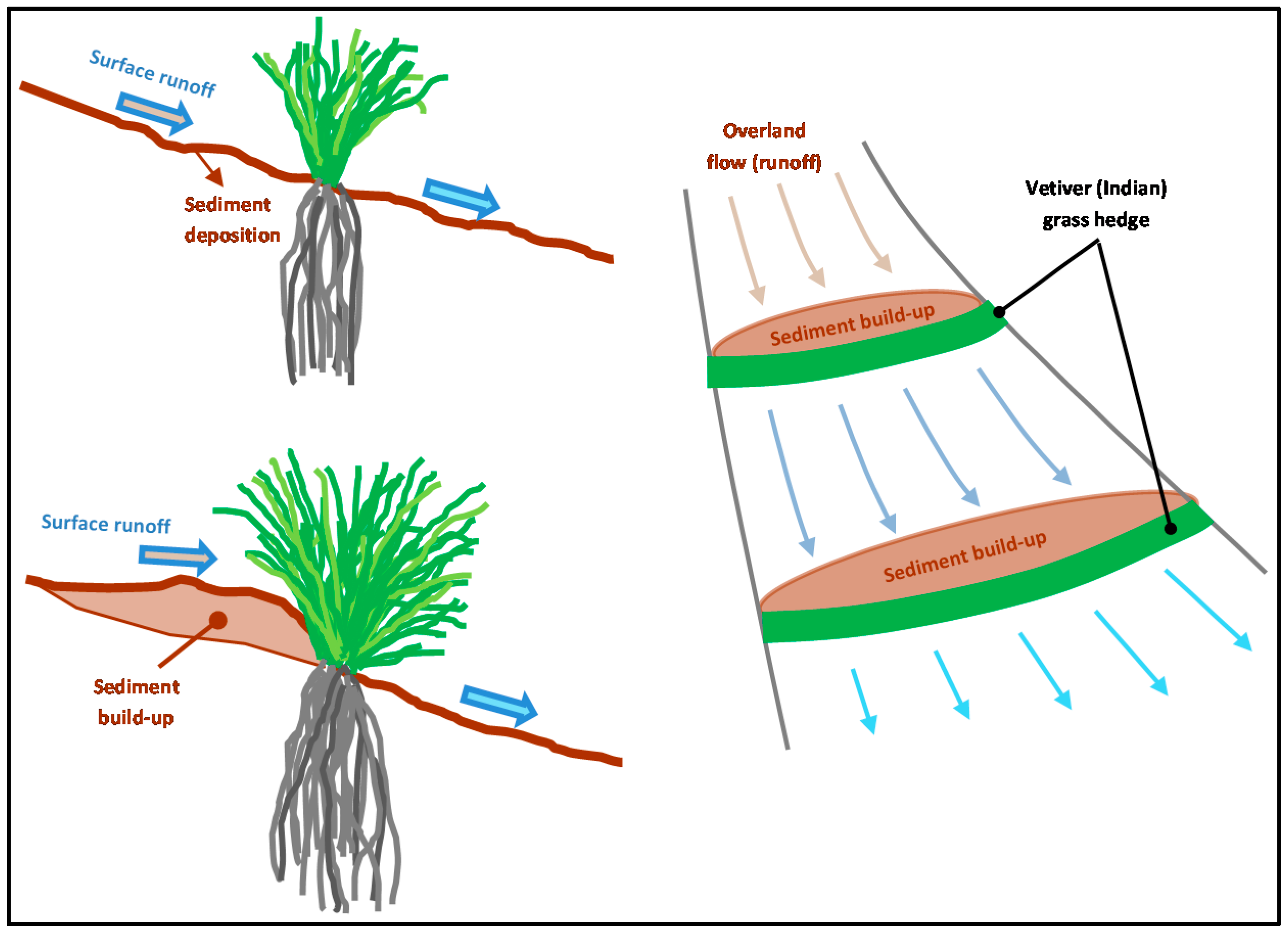
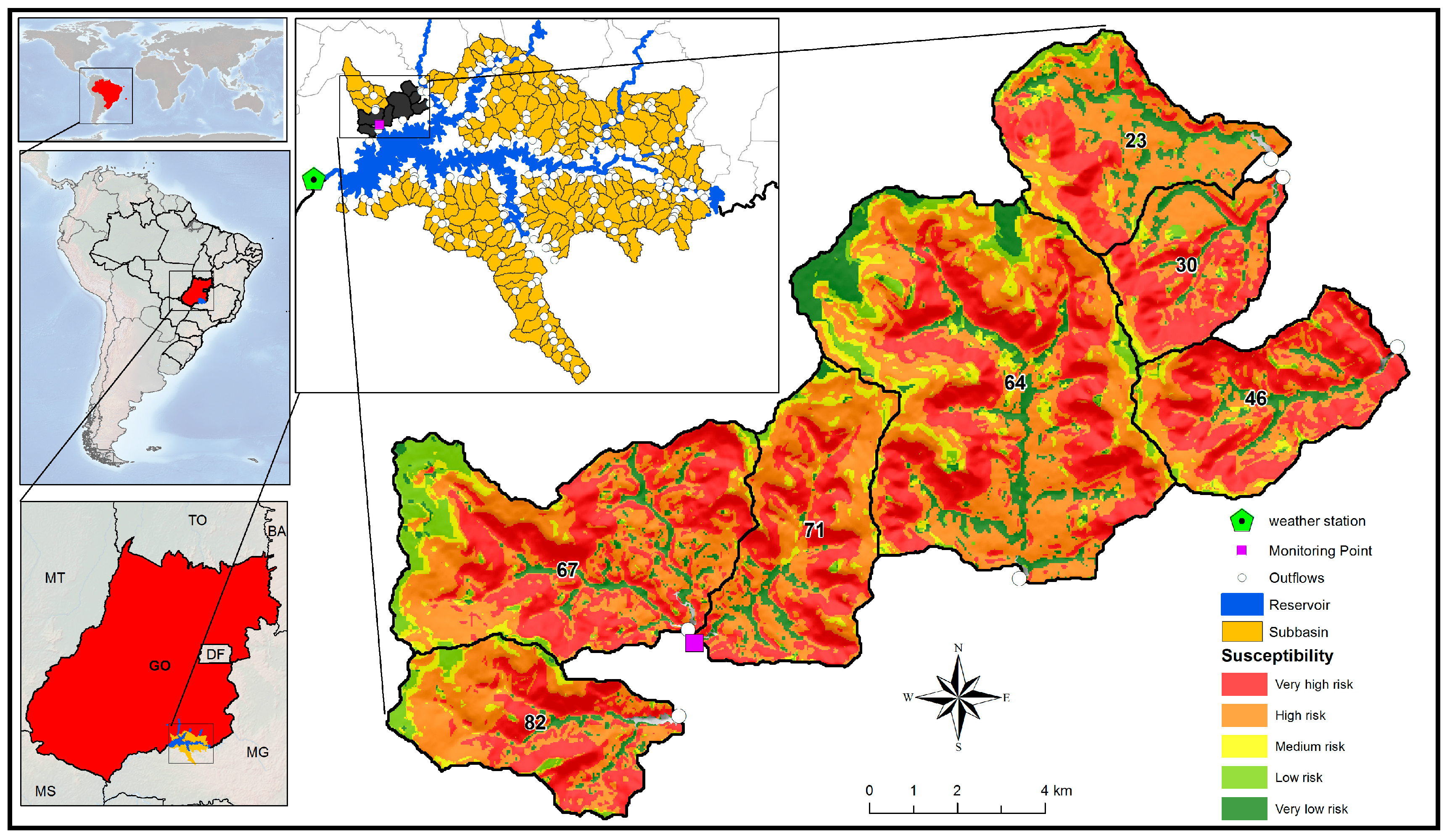
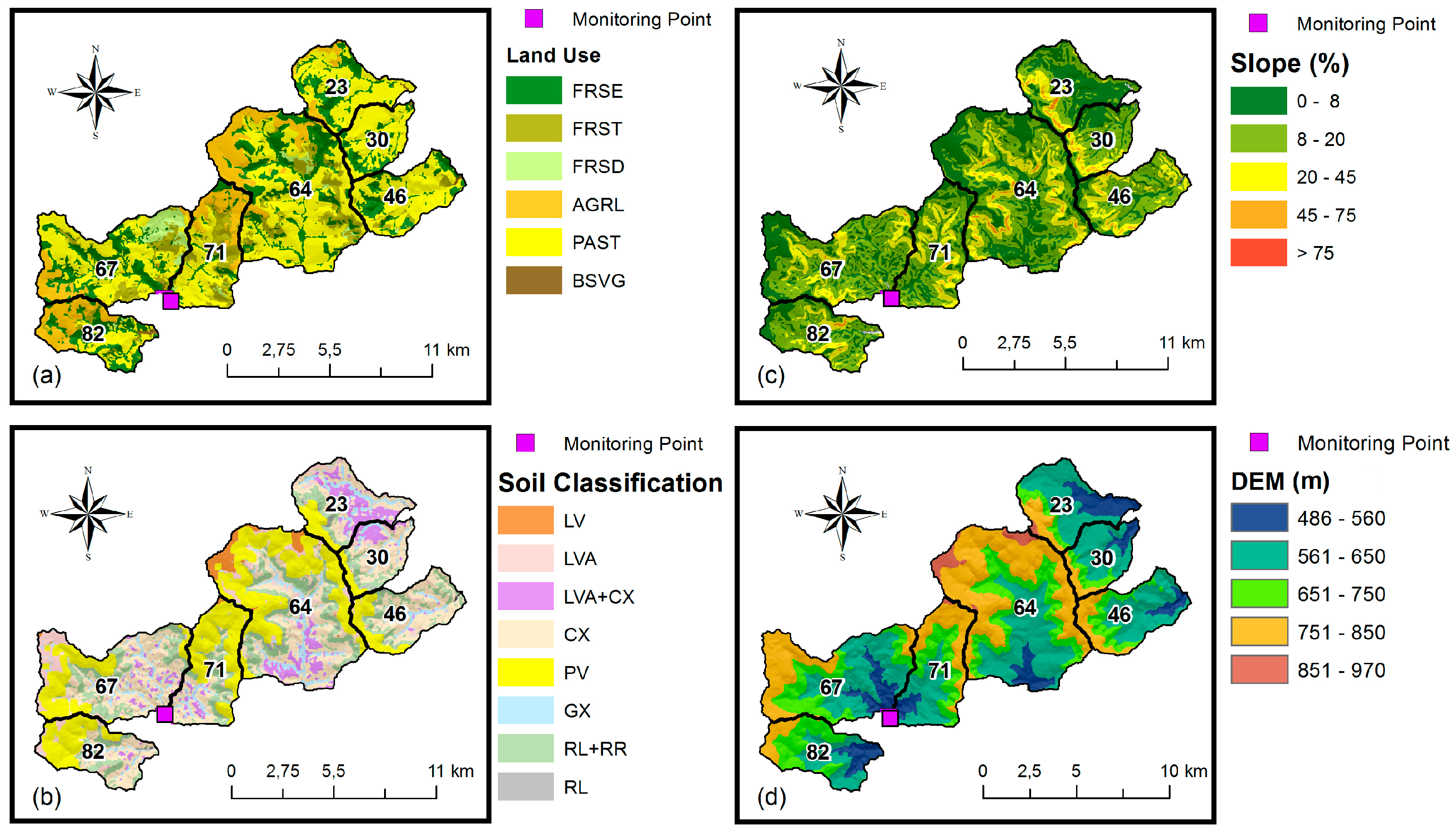
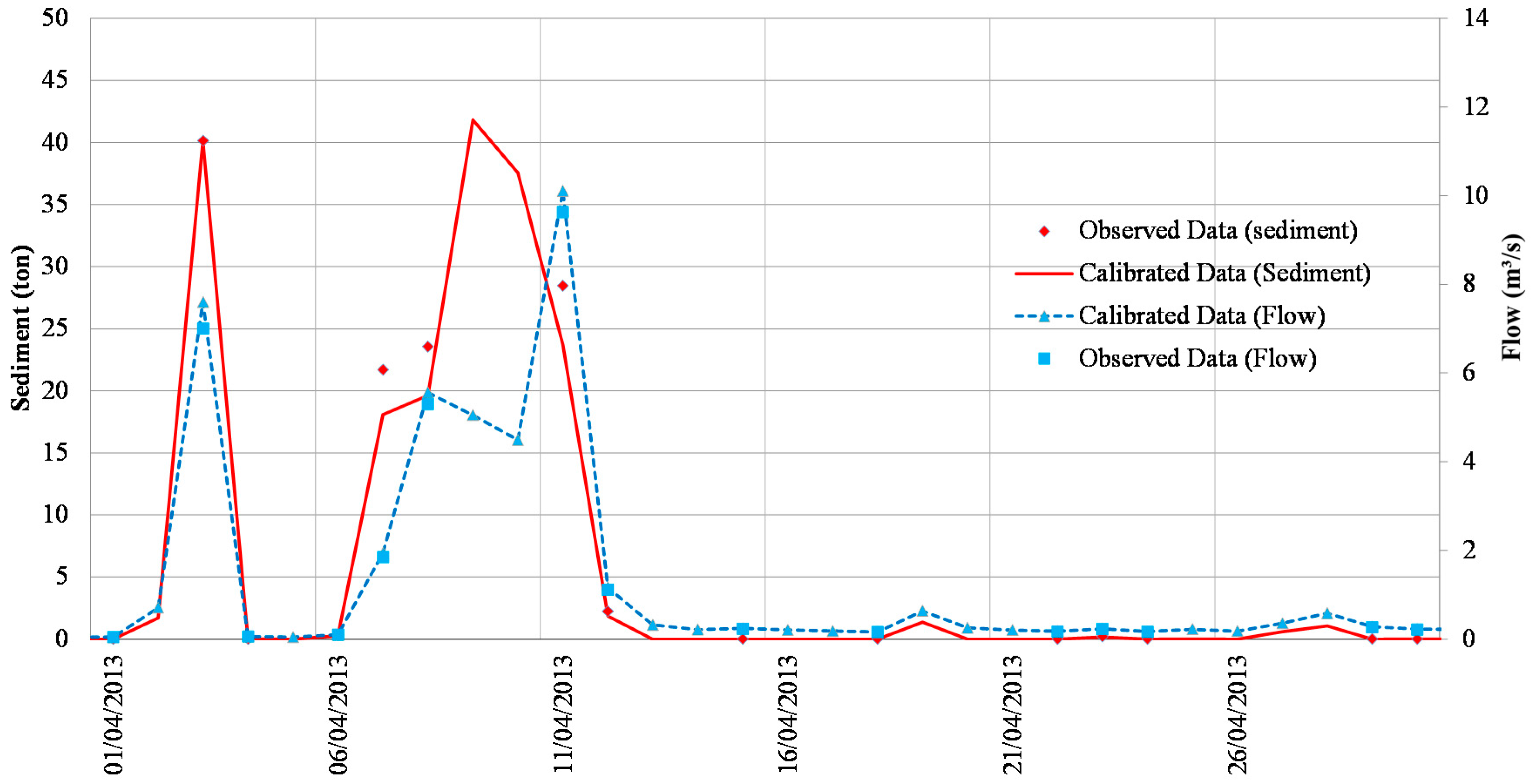
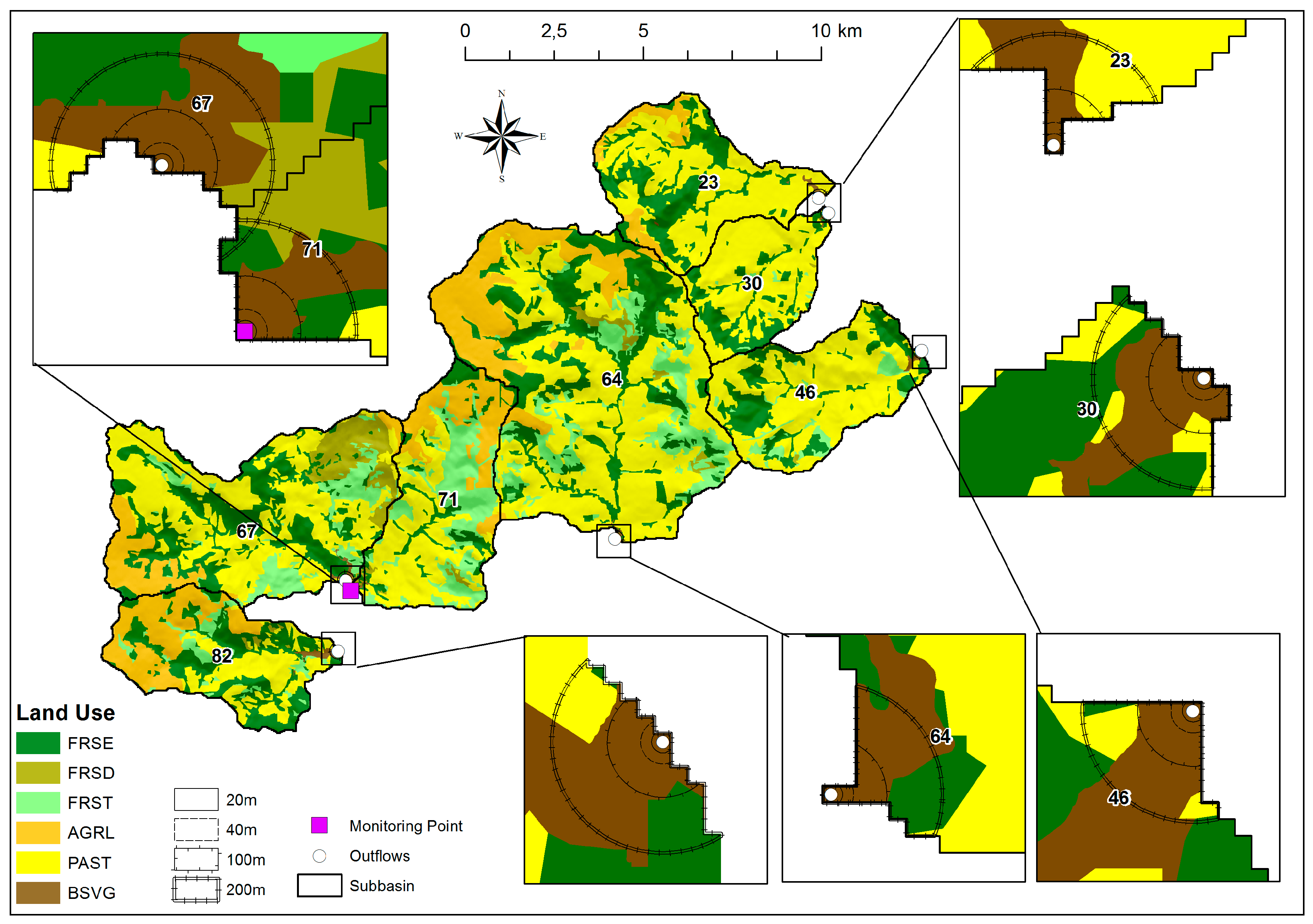

| Study | Application | Scale | Results |
|---|---|---|---|
| [11] | Experimental investigation of runoff reduction and sediment removal by vegetated filter strips into cropland. Study with grass species including Vetiver grass. (Debre Mewi Basin Ethiopia) | Use of 1.5 m wide strips | Desho with the highest tiller number and density, and the second highest in root length revealed better STE than the other grass species, Vetiver (59%), Senbelet (49%), Akirma (36%) and Sebez (20%). |
| [12] | Experimental investigation of runoff reduction and sediment removal by vegetated filter strips into cropland. Effectiveness of tropical grass species (Elephant grass, Lemon grass, paspalum and sugarcane) as sediment filters in the riparian zone of Lake Victoria, Uganda. | At filter lengths of 2.5, 5 and 10 m. | Under natural rainfall, more than 70% of sediment was trapped in the first 5 m, and lengthening the strip to 10 m only resulted in a marginal increase in sediment trapping effectiveness. |
| [13] | Experimental investigation in Three Gorges Dam Area, China. Contour hedgerows have been used in this area to control soil erosion and to improve hillslope stability in the catchment of this river section. | Use of 10 m wide strips. | Measured runoffs during natural rainfall events show that all types of plant hedgerow had notable effects on reducing runoff and soil loss. The reduction in soil losses ranged from 18.4% to 70.0% and runoffs were reduced by 17.2% to 70.8%. |
| [14] | Experimental investigation. Reduction of runoff and soil loss over steep slopes by using Vetiver. Field experiments were conducted at Kasetsart University, Thailand. | 2 m in width, 3 m in vertical height, 10.44, 8.08, and 6.71 m in length. | The study found that Vetiver hedgerows reduce runoff volume by 31%–69% and soil loss by 62%–86% on steep slopes of 30%–50%. |
| [15] | Experimental investigation of runoff reduction and sediment removal by vegetated filter strips into cropland. Two types of hedgerow widths (two-row and three-row) were planted for each of three species of vegetation Bahia grass, Vetiver and Daylily. (Red soil region of China) | The hedgerows were 10 m long with a spacing of 5 m between the rows. | The three selected vegetation types exhibited the similar efficiencies in filtering sediment under the experimental conditions. Generally, the soil loss from the grass hedges was controlled by the characteristics of the grass stems, regardless of the hedge widths. |
| [16] | Experimental investigation of runoff reduction and sediment removal by vegetated filter strips into cropland. Six different treatments: control (without any treatment), soil bund alone, and soil bund combined with tephrosia, Vetiver grass, Elephant grass and a local grass called Sembelet. (northwestern of Ethiopia) | Each of the treatments was tested on an area of 180 m2. | Soil bund combined with Elephant grass had the lowest runoff (40%) and soil loss (63%) as compared to the other treatments. |
| Parameter | Description | Rank | Sensitivity Level | Sensitivity Index (SI) |
|---|---|---|---|---|
| Cn2 | Initial SCS runoff curve number | 1 | High | 4.25 |
| USLE_P | USLE equation support | 2 | High | 2.90 |
| Sol_Z | Soil Depth | 3 | High | 1.31 |
| Esco | Soil evaporation compensation | 4 | Intermediate | 0.98 |
| Slope | Average slope steepness | 5 | Intermediate | 0.96 |
| Sol_Awc | Available water capacity | 6 | Intermediate | 0.85 |
| Canmx | Max canopy storage | 7 | Intermediate | 0.83 |
| Blai | Max potential lead area index | 8 | Intermediate | 0.82 |
| Biomix | Biological efficiency | 9 | Weak | 0.63 |
| Surlag | Surface runoff lag time | 10 | Weak | 0.55 |
| Slsubbsn | Average slope length | 11 | Weak | 0.28 |
| Variable | Ranking | Original | Multiplying Factor | Final Values |
|---|---|---|---|---|
| Cn2 | 1 | 42.50 | 1.19 | 50.58 |
| USLE_P | 2 | 0.29 | 3.07 | 0.89 |
| Sol_Z (mm) | 3 | 1.31 | 0.66 | 0.86 |
| Sub-Basin | Area (ha) | Baseline Sed. (ton/Year) | Indian Grass Buffer | |||||||
|---|---|---|---|---|---|---|---|---|---|---|
| 20 m | 40 m | 100 m | 200 m | |||||||
| Sed. (ton/Year) | Reduction (%) | Sed. (ton/Year) | Reduction (%) | Sed. (ton/Year) | Reduction (%) | Sed. (ton/Year) | Reduction (%) | |||
| 23 | 1766 | 3693 | 3683 | 0.27 | 3679 | 0.38 | 3663 | 0.81 | 3643 | 1.35 |
| 30 | 1154 | 2272 | 2265 | 0.31 | 2262 | 0.44 | 2251 | 0.92 | 2237 | 1.54 |
| 46 | 1719 | 3619 | 3593 | 0.72 | 3589 | 0.83 | 3541 | 2.16 | 3489 | 3.59 |
| 64 | 5167 | 10,004 | 9998 | 0.06 | 9996 | 0.08 | 9986 | 0.18 | 9974 | 0.30 |
| 67 | 3318 | 2386 | 2382 | 0.17 | 2381 | 0.21 | 2374 | 0.50 | 2366 | 0.84 |
| 71 | 1960 | 2468 | 2445 | 0.93 | 2436 | 1.30 | 2425 | 1.74 | 2385 | 3.36 |
| 82 | 1628 | 3682 | 3669 | 0.35 | 3663 | 0.52 | 3643 | 1.06 | 3605 | 2.09 |
| Sum. | 16,712 | 28,124 | 28,035 | 0.32 | 28,006 | 0.42 | 27,883 | 0.86 | 27,699 | 1.51 |
© 2016 by the authors; licensee MDPI, Basel, Switzerland. This article is an open access article distributed under the terms and conditions of the Creative Commons Attribution (CC-BY) license (http://creativecommons.org/licenses/by/4.0/).
Share and Cite
Luz, M.P.; Beevers, L.C.; Cuthbertson, A.J.S.; Medero, G.M.; Dias, V.S.; Nascimento, D.T.F. The Mitigation Potential of Buffer Strips for Reservoir Sediment Yields: The Itumbiara Hydroelectric Power Plant in Brazil. Water 2016, 8, 489. https://doi.org/10.3390/w8110489
Luz MP, Beevers LC, Cuthbertson AJS, Medero GM, Dias VS, Nascimento DTF. The Mitigation Potential of Buffer Strips for Reservoir Sediment Yields: The Itumbiara Hydroelectric Power Plant in Brazil. Water. 2016; 8(11):489. https://doi.org/10.3390/w8110489
Chicago/Turabian StyleLuz, Marta P., Lindsay C. Beevers, Alan J. S. Cuthbertson, Gabriela M. Medero, Viviane S. Dias, and Diego T. F. Nascimento. 2016. "The Mitigation Potential of Buffer Strips for Reservoir Sediment Yields: The Itumbiara Hydroelectric Power Plant in Brazil" Water 8, no. 11: 489. https://doi.org/10.3390/w8110489






